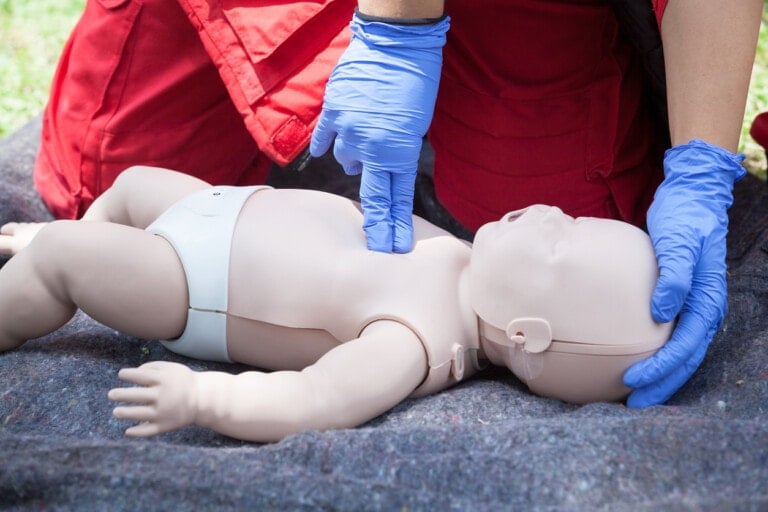Toddlers love exploring the world, but with that comes the risk of injury. Many toddlers love to put things in their mouths or run around while eating. This can lead to choking and the necessity for CPR. Knowing how to perform toddler CPR correctly is a skill every parent or caregiver should have in their tool belt.
Performing toddler CPR is a scary experience for any parent or caregiver. Learning the correct steps for toddler CPR is essential, but so is learning ways to prevent choking, which can lead to the need for CPR. By knowing how to perform toddler CPR, you can be prepared if an emergency arises with your little explorer.
What is CPR?
CPR, or cardiopulmonary resuscitation, is a hands-on action to help someone when their heart stops beating. When a child’s heart stops beating, blood cannot reach the brain and lungs. Chest compressions keep blood moving through the body, and giving the child breaths helps provide oxygen to their lungs.1
Even though it is not common for a child’s heart to stop beating, there are a few reasons why this might happen, including the following:2
- Choking
- Drowning
- An injury to their head
- Large amounts of bleeding
- Lung diseases
- Poisoning
- Suffocation
How Do You Perform Toddler CPR?
Performing CPR on a toddler can be frightening. Knowing how to perform toddler CPR properly will help you remain calm and focused and better able to help. According to the American Red Cross, the steps for performing toddler CPR are as follows:3
- Ensure you and the toddler are in a safe place with enough space to perform CPR.
- If the toddler is not responding, shout the toddler’s name and tap on their shoulder to check for a response.
- While checking for a response, check to see if they are breathing. Do not check for more than 10 seconds.
- If you are with other people, tell someone to call 9-1-1. If you are alone, start CPR.
- Kneel to the side of the toddler.
- Place the heel of your hand in the middle of the toddler’s chest to start chest compressions. While keeping your arms straight, push down hard and fast on the toddler’s chest about 2 inches deep.
- Perform a set of 30 chest compressions. Counting the compressions out loud will help you keep track.
- Give two breaths to the toddler by tilting their head back slightly, closing their nose with your fingers, and covering their mouth with your own. Blow into the toddler’s mouth and watch for their chest to rise.
- Repeat the cycle of 30 compressions followed by two breaths.
- If you are alone, complete two minutes of CPR and then call 9-1-1.
- Continue to perform CPR until help arrives.
Toddler CPR: Choking and How to Spot the Signs
Toddlers have small airways that can easily become blocked as they learn to chew their food properly. When something blocks their airway, oxygen and blood cannot reach their brain. It can be difficult to spot the signs of choking, but if you know what to look for, you will easily spot a child in trouble. Some signs of choking include:4
- Noisy breathing
- A squeaky sound when they breathe.
- Cough that is either weak or forceful
- Blue color to the skin or lips
- Inability to talk.
- Their hands at their throat
- A look of panic, shock, or confusion
- Loss of consciousness
If the toddler can cough forcefully, or they can talk, cry or laugh, do not intervene, as the object is most likely to come out on its own.4
How Do You Help a Toddler Who is Choking?
Removing the object from your toddler’s airway involves the Heimlich maneuver. This technique uses abdominal thrusts to help expel the object from your toddler’s airway. Follow these steps to perform abdominal thrusts:5
- Kneel behind your toddler so that your arms are wrapped around their waist.
- With one hand, place a fist on their abdomen with your thumb facing their belly button.
- Hold your fisted hand firmly with your other hand.
- Use your hands to make a quick upward and inward thrusting motion.
- Continue abdominal thrusts until the object comes out.
You can also perform back blows if you cannot do abdominal thrusts. The steps to performing back blows are as follows:5
- Kneel behind your toddler.
- Take one of your arms and wrap it around their upper body.
- Lean your child forward until their chest is parallel to the ground.
- Using the heel of your hand, firmly hit the toddler’s back between their shoulder blades.
- Keep providing back blows until the object comes out.
If at any time your child stops breathing, stop performing abdominal thrusts or back blows and begin CPR. Call 9-1-1 and continue CPR until help arrives. If you see the object in the child’s mouth and it is loose, remove it. If you can see the object, but it is in their throat or not loose, do not try and remove it. You can accidentally push the object further into their throat.5
How To Avoid Choking in Toddlers
Working on eliminating choking hazards is the best way to prevent your toddler from choking. Properly preparing food will help to reduce the risk of your toddler choking. Here are a few tips:6
- Cook or steam hard foods so that you can easily pierce them with a fork.
- Peel the skin and remove any seeds or pits from fruits and vegetables.
- Chop foods into thin strips or small pieces no larger than ½ inch.
- Puree or mash raw fruits and vegetables.
- Make sure to remove all bones from meat and fish.
- Puree tough meats.
- Do not serve any foods that are as wide as a nickel.
- Avoid serving round or tube-shaped foods whole; cut them into strips before serving.
- Avoid hard candies, chewy candies, lollipops, and chewing gum.
- Allow plenty of time to eat meals and snacks, and have your child sit upright.
Learning CPR is not only a vital skill to learn, but it will also help you to stay calm during an emergency. A hands-on learning course is one of the best ways to learn CPR. You can sign up for a hands-on CPR skills class through your local chapter of the American Red Cross.































